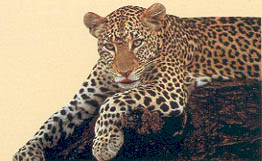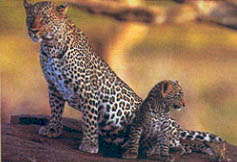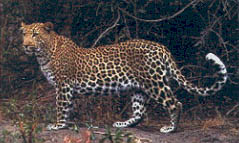From your sweet little pussy to your man-eating lion, the
most catlike of all the cats is the Leopard. Secretive, silent, smooth and supple,
Panthera Pardus is one mean solitary creature of the night. Weighing in at up to 90 kg and
almost 3 metres long from nose to tail, with canine teeth 40mm long in their massive,
powerful jaws, the hungry adult leopard needs to consume around 3kg of food daily in the
form of anything from dung beetles to deer. In order to satisfy this hunger they’ll
readily scavenge from other predators’ kills, or even from animals dead or dying of
natural causes. Their own kills usually occur after a painstaking stalk and a short chase,
followed by the throttling of their prey. They also appear to have a particular liking for
dogs as food, often take livestock and may attack humans if cornered or injured.
They’re extremely agile climbers and frequently store the remains of their kill high
up in the branches of trees which, just like the back of the top shelf in a supermarket,
keeps it out of everyone else’s reach.
 The life of a leopard is not an easy one.
Three months after she meets Mr. Leopard, Mrs. Leopard gives birth to between 2–4
cubs. These cubs, with the odds stacked against them, are born in sheltered hollows or
caves with only a 50-50 chance of survival and thereafter a mere 1 in 3 chance of reaching
adulthood. For the first few weeks, the mother regularly moves her delicate baby cubs to
different shelters every two or three days in an attempt to avoid predators. Their tiny
little eyes only begin to open a week after birth but, from then onwards, they mature
swiftly to reach full independence after a year. They may live up to 20 years, though in
the wild usually survive only half that time.
The life of a leopard is not an easy one.
Three months after she meets Mr. Leopard, Mrs. Leopard gives birth to between 2–4
cubs. These cubs, with the odds stacked against them, are born in sheltered hollows or
caves with only a 50-50 chance of survival and thereafter a mere 1 in 3 chance of reaching
adulthood. For the first few weeks, the mother regularly moves her delicate baby cubs to
different shelters every two or three days in an attempt to avoid predators. Their tiny
little eyes only begin to open a week after birth but, from then onwards, they mature
swiftly to reach full independence after a year. They may live up to 20 years, though in
the wild usually survive only half that time.
Their coats are typically yellow above and white below, with dark
spots arranged in rosettes over much of their body. Although, as we know, they never
change their spots, no two leopards have the same pattern and, as a result, several forms
of the same species have been named. A black form, in which both the background colour and
the spots are black is known as the Black Panther which is still to be found in areas of
the Far East. The pink form, Sellersicus Pinkypus, cerebrally challenged, shaved to the
skin, well manicured and posing like a French species, is fortunately to be found only in
cartoons. However, much less common are the Barbary, South Arabian, Anatolian, Amur and
our very own Sinai leopard, all now listed as endangered species and teetering on the edge
of extinction.
 As with all cats, the leopard makes a variety of easy to understand noises.
These noises vary within the different forms of leopard and undoubtedly change according
to mood. The sound of communication between leopards is usually likened to a series of
harsh smokers coughs, moving up a scale to throaty growls when threatened or, just like
your favourite pussy, a deep soft purring of contentment which almost makes you want to
reach down and tickle them.
As with all cats, the leopard makes a variety of easy to understand noises.
These noises vary within the different forms of leopard and undoubtedly change according
to mood. The sound of communication between leopards is usually likened to a series of
harsh smokers coughs, moving up a scale to throaty growls when threatened or, just like
your favourite pussy, a deep soft purring of contentment which almost makes you want to
reach down and tickle them.
Both males and females are territorial, although the females tend
to have a segregated, smaller home range often overlapped by that of the male. These
territories can vary from 10 square km in areas of abundant prey up to 400 square km in
arid areas. Fortunately for the leopards, they are not dependant on a water source for
survival since they imbibe enough fluids from their prey. However, unusually for a cat,
the leopard takes to water readily and is a good swimmer.
 Being extremely adaptable, leopards are to
be found in almost any kind of terrain, though they seem to prefer areas with rocky
outcrops and mountains of which we have an abundance here in Sinai. Unfortunately, their
available habitats are swiftly decreasing due to the spread of the human population.
During the 60’s and 70’s, around 50,000 leopards were killed worldwide every
year in order to satisfy our Dylanesque desire for wearing leopardskin pillbox hats.
Primarily due to the collapse of the fur trade in the 80’s the leopards numbers are
once again stable. Now their two main enemies are the poor Bedouin farmers trying to
protect their stock and a few big, brave, trophy hunters who continue to shoot leopards
either at night using artificial lights or when they’re already caught in box traps
– an admirable sport for admirable men.
Being extremely adaptable, leopards are to
be found in almost any kind of terrain, though they seem to prefer areas with rocky
outcrops and mountains of which we have an abundance here in Sinai. Unfortunately, their
available habitats are swiftly decreasing due to the spread of the human population.
During the 60’s and 70’s, around 50,000 leopards were killed worldwide every
year in order to satisfy our Dylanesque desire for wearing leopardskin pillbox hats.
Primarily due to the collapse of the fur trade in the 80’s the leopards numbers are
once again stable. Now their two main enemies are the poor Bedouin farmers trying to
protect their stock and a few big, brave, trophy hunters who continue to shoot leopards
either at night using artificial lights or when they’re already caught in box traps
– an admirable sport for admirable men.
So the next time you ponder over whether or not to get that
designer leopardskin handbag, spare a thought for this graceful, wild creature which has
been almost wiped from the face of the earth solely to pander to our vanity. After all,
would you even consider carrying your purse inside your dead pet pussy ?
back
 The life of a leopard is not an easy one.
Three months after she meets Mr. Leopard, Mrs. Leopard gives birth to between 2–4
cubs. These cubs, with the odds stacked against them, are born in sheltered hollows or
caves with only a 50-50 chance of survival and thereafter a mere 1 in 3 chance of reaching
adulthood. For the first few weeks, the mother regularly moves her delicate baby cubs to
different shelters every two or three days in an attempt to avoid predators. Their tiny
little eyes only begin to open a week after birth but, from then onwards, they mature
swiftly to reach full independence after a year. They may live up to 20 years, though in
the wild usually survive only half that time.
The life of a leopard is not an easy one.
Three months after she meets Mr. Leopard, Mrs. Leopard gives birth to between 2–4
cubs. These cubs, with the odds stacked against them, are born in sheltered hollows or
caves with only a 50-50 chance of survival and thereafter a mere 1 in 3 chance of reaching
adulthood. For the first few weeks, the mother regularly moves her delicate baby cubs to
different shelters every two or three days in an attempt to avoid predators. Their tiny
little eyes only begin to open a week after birth but, from then onwards, they mature
swiftly to reach full independence after a year. They may live up to 20 years, though in
the wild usually survive only half that time. From your sweet little pussy to your man-eating lion, the
most catlike of all the cats is the Leopard. Secretive, silent, smooth and supple,
Panthera Pardus is one mean solitary creature of the night. Weighing in at up to 90 kg and
almost 3 metres long from nose to tail, with canine teeth 40mm long in their massive,
powerful jaws, the hungry adult leopard needs to consume around 3kg of food daily in the
form of anything from dung beetles to deer. In order to satisfy this hunger they’ll
readily scavenge from other predators’ kills, or even from animals dead or dying of
natural causes. Their own kills usually occur after a painstaking stalk and a short chase,
followed by the throttling of their prey. They also appear to have a particular liking for
dogs as food, often take livestock and may attack humans if cornered or injured.
They’re extremely agile climbers and frequently store the remains of their kill high
up in the branches of trees which, just like the back of the top shelf in a supermarket,
keeps it out of everyone else’s reach.
From your sweet little pussy to your man-eating lion, the
most catlike of all the cats is the Leopard. Secretive, silent, smooth and supple,
Panthera Pardus is one mean solitary creature of the night. Weighing in at up to 90 kg and
almost 3 metres long from nose to tail, with canine teeth 40mm long in their massive,
powerful jaws, the hungry adult leopard needs to consume around 3kg of food daily in the
form of anything from dung beetles to deer. In order to satisfy this hunger they’ll
readily scavenge from other predators’ kills, or even from animals dead or dying of
natural causes. Their own kills usually occur after a painstaking stalk and a short chase,
followed by the throttling of their prey. They also appear to have a particular liking for
dogs as food, often take livestock and may attack humans if cornered or injured.
They’re extremely agile climbers and frequently store the remains of their kill high
up in the branches of trees which, just like the back of the top shelf in a supermarket,
keeps it out of everyone else’s reach.
 As with all cats, the leopard makes a variety of easy to understand noises.
These noises vary within the different forms of leopard and undoubtedly change according
to mood. The sound of communication between leopards is usually likened to a series of
harsh smokers coughs, moving up a scale to throaty growls when threatened or, just like
your favourite pussy, a deep soft purring of contentment which almost makes you want to
reach down and tickle them.
As with all cats, the leopard makes a variety of easy to understand noises.
These noises vary within the different forms of leopard and undoubtedly change according
to mood. The sound of communication between leopards is usually likened to a series of
harsh smokers coughs, moving up a scale to throaty growls when threatened or, just like
your favourite pussy, a deep soft purring of contentment which almost makes you want to
reach down and tickle them. Being extremely adaptable, leopards are to
be found in almost any kind of terrain, though they seem to prefer areas with rocky
outcrops and mountains of which we have an abundance here in Sinai. Unfortunately, their
available habitats are swiftly decreasing due to the spread of the human population.
During the 60’s and 70’s, around 50,000 leopards were killed worldwide every
year in order to satisfy our Dylanesque desire for wearing leopardskin pillbox hats.
Primarily due to the collapse of the fur trade in the 80’s the leopards numbers are
once again stable. Now their two main enemies are the poor Bedouin farmers trying to
protect their stock and a few big, brave, trophy hunters who continue to shoot leopards
either at night using artificial lights or when they’re already caught in box traps
– an admirable sport for admirable men.
Being extremely adaptable, leopards are to
be found in almost any kind of terrain, though they seem to prefer areas with rocky
outcrops and mountains of which we have an abundance here in Sinai. Unfortunately, their
available habitats are swiftly decreasing due to the spread of the human population.
During the 60’s and 70’s, around 50,000 leopards were killed worldwide every
year in order to satisfy our Dylanesque desire for wearing leopardskin pillbox hats.
Primarily due to the collapse of the fur trade in the 80’s the leopards numbers are
once again stable. Now their two main enemies are the poor Bedouin farmers trying to
protect their stock and a few big, brave, trophy hunters who continue to shoot leopards
either at night using artificial lights or when they’re already caught in box traps
– an admirable sport for admirable men.